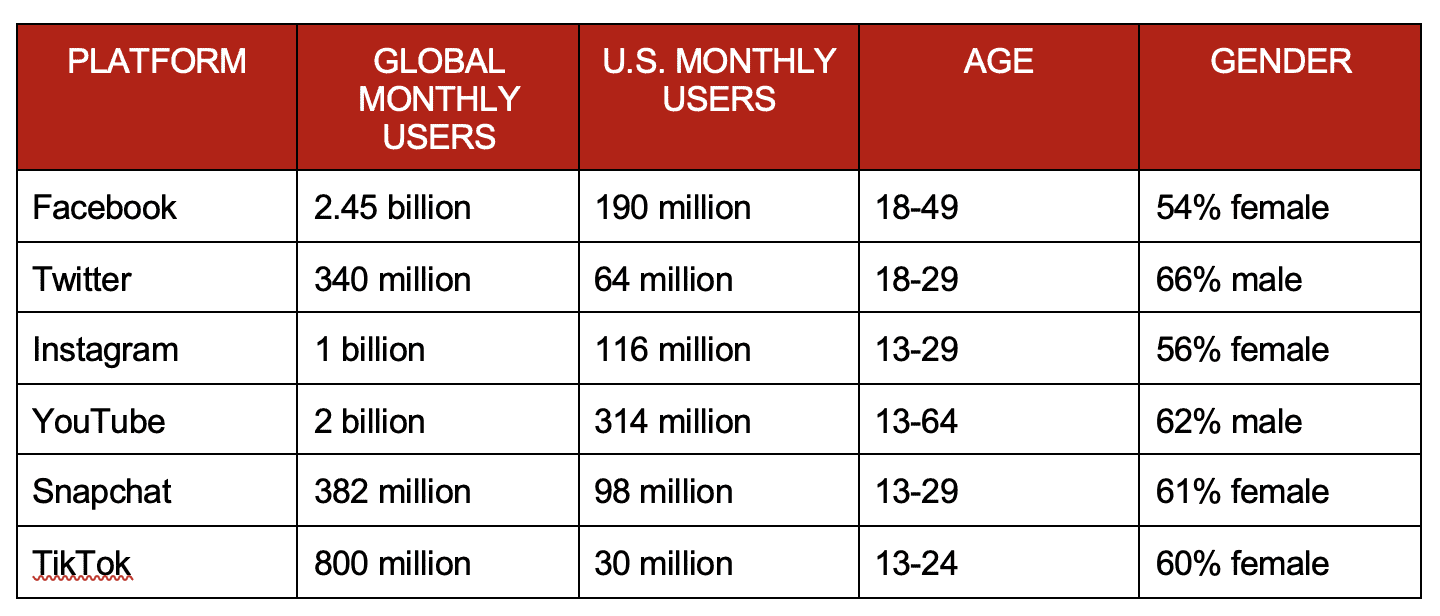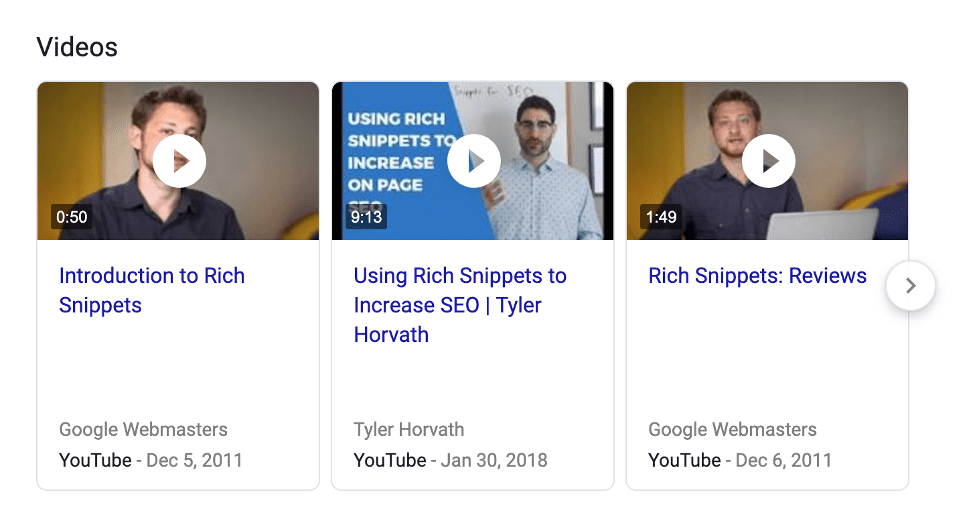
It’s difficult to overstate the importance of video for rapidly reaching a widespread online audience. YouTube alone has more than 2 billion active monthly users, watching 5+ billion videos uploaded by over 50 million content creators. Over 95 percent of the global internet population watches YouTube, and that includes 73 percent of U.S. adults. Through mobile alone, YouTube reaches more American 18-34-year-olds than any TV network. Think about that—you can get the same reach from a YouTube channel video you create and upload from your home office as you could get from spending thousands advertising on TV.
YouTube isn’t all celebrities and professional production either. According to Think with Google, providing content relevant to the user’s passion was 3 times more important than whether or not the video contained a recognizable figure, and 1.6 times more important than overall production quality. While better production values are preferable to the average viewer, don’t let the fact you’re working from a basic home video studio – or just your phone – prevent you from joining the video content marketing frenzy.
What is video content marketing?
While online video is enjoying a meteoric rise, video content marketing is just a small part of the whole. The purpose of video marketing is the same as blogging , or any other promotional content: to raise awareness of and promote your business. You do this, not by creating infomercials, but by creating interesting videos that serve a purpose or solve a question for the watcher.
As an edupreneur, you’re probably already familiar with the kind of questions that learners ask time and time again. Answering these questions is a great place to start a video marketing campaign. If you have already recorded a lesson or seminar on the subject, even better. You might be able to repurpose existing content to create your first marketing video without putting in a lot of extra work.
Always aim to provide value first. Answer a common question, explain how something works, or tell an amusing or interesting anecdote from your past experience that demonstrates your expertise in your field. The goal is to position yourself as an authority while providing content that potential learners want.
Choosing a video platform
Although I cited stats about YouTube at the beginning of this article, it isn’t the only video hosting platform in town. Depending on who your ideal learners are, you might get better results on a more targeted platform such as Facebook, Snapchat, or TikTok.

Your target audience should be the primary demographic you use to determine the best platform for hosting or cross-posting your video content marketing efforts, but YouTube’s reach and wide audience base makes it a good choice regardless of demographics. YouTube’s position as a Google company could also add another benefit—improved search engine results.
Google already displays relevant videos at the top of Search Engine Results Pages (SERPs) as video rich snippets, so hosting your content on YouTube could give it an advantage when it comes to being shown by Google. However if your goal is to get more visitors to your website, YouTube probably isn’t the right option for you. That’s because Google will privilege the YouTube domain and try to keep web users on its property, not yours.

If you want to draw learners to your website, you are better off self-hosting or using a platform such as Vimeo to embed video content into your site. This also has a positive effect on SEO—adding video to your website increases organic traffic by more than 150 percent, and web pages with embedded video are 53 times more likely to appear on the first page of Google than those without video.
Before you begin your video marketing campaign, it’s important to establish the goal you want to achieve. Is it brand awareness, more links and better SEO for your website, sales of a particular product, or something else? Let your goal guide your decision on where to upload your video and how to distribute it. In general, to improve visibility and awareness, choose a social network (or three) to share your video. If you want to perform better on SERPs and build backlinks, consider self-hosting your videos instead.
Finding your audience
Most edupreneurs will probably find that, at least in the beginning, cross-posting on several platforms generates the best results. Perhaps your audience is most active on Snapchat, but you have no idea how the platform works or what strategy to employ to reach them. You might be better off working with a more familiar platform, such as YouTube, even if it means reaching a smaller overall segment of your target audience.
Of course just because you post on the right platform, that doesn’t mean viewers will automatically find your video and start watching. Over 500 hours of new content is uploaded to YouTube every minute, meaning demand for viewers’ attention is fierce.
The most important way to get views on your videos is by providing quality content that fills a deficit in what is currently available. Explore the videos aimed at learners wanting to know more about your field. Maybe the basics have already been covered a hundred times over, but there’s a lack of material for more advanced learners. Or perhaps there’s tons of cool amateur footage, but no educational or technical explanations of what’s going on. From the science behind weather phenomena to how computer coding works, if you can teach it, you can make a video about it.
Once you’ve decided on a content strategy for your video marketing campaign, research what appeals to your target audience in order to get their attention. Remember the viewer’s interest in the subject matter beats out the host and production values, so concentrate on getting that right.
All about video SEO
Search engine optimization (SEO) doesn’t only apply to websites and blog posts. Video SEO is critical to drawing learners to your videos and getting views. In simple terms, SEO is just the methods you employ to tell search engine crawlers what your content is about. The more accurately search engines can document your content, the higher the chance it will be considered a relevant result to search engine queries.
With written content, SEO is comparatively easy. Crawler bots search for keywords and phrases that help them index the page’s contents. When it comes to video content, things are more complicated. In part this is because language and image processing technology is far from perfect, making it harder for algorithms to determine what is happening in your videos. By focusing on your video SEO, you give search engines more information and that in turn leads to better indexing and improved SERPs results.
If you really want to maximize your video SEO, take a look at Google’s research paper on how videos are interpreted and their contents quantified. This gives us a valuable insight into how engineers at Google are approaching video SEO, and where their focus lies. In brief, you need to keep your audio clear and concise, illustrate your words appropriately, and make the best use of closed captions.
Improve your audio quality
While viewers are pretty forgiving when it comes to production values, language processing algorithms are not. If you’ve ever looked at a computer generated transcript or used speech-to-text software, you’re probably aware of how badly computers can mishear what you’re saying, even when you’re trying to enunciate every word as clearly as possible. In a social media video, when you’re probably speaking fairly quickly and keeping the tone informal, computers aren’t going to understand everything you say.
Accepting that fact, you can still aid a bot’s understanding of your video content by improving your audio quality. Eliminate as much background noise as possible, don’t play music while you’re speaking, and if you only have the budget for one investment, make it a good quality mic.
Show as you tell
If you publish how-to videos or include any kind of demonstration, ensure that your visual content matches your words. For cooking videos, when you say “Put the pan on the burner,” then show the pan being placed on the burner. Bots crawl the still frames from videos and try to determine what is being shown in order to add more depth to their understanding and indexing of the video. Just as with audio algorithms, image-recognition software isn’t always completely accurate, but by keeping your visual content relevant you can help improve the video’s overall SEO.
Stay on point
If you’ve ever searched for a recipe online, you know the annoyance of having to scroll through endless pages of backstory and anecdotes to get to the ingredients. This kind of writing is beneficial to blog authors, but detrimental to video SEO. Using direct action verbs and avoiding unnecessary filler gives algorithms a clearer sense of what your video is about and what is happening in each frame.
Add or fix closed captions
If you’re using YouTube to host your video, Google will automatically apply closed captions after it is published. These are speech-to-text generated captions and, as with all speech-to-text software, they’re never completely accurate. This is problematic because it makes it harder for search engine crawlers to understand what your video is about, but also has real-world consequences for your watchers, and thus affects your video’s popularity.
Firstly, about 5 percent of the population is deaf or hard of hearing. That’s 1 in 20 people you could alienate if you don’t use closed captions, or rely on captions that aren’t comprehensible. About the same percentage (1.5 billion people worldwide) speak English—most likely the language you’ll use in your video. While your target learners will probably speak the same language as you, using closed captions means your video can be translated into other languages, giving it a wider reach and greater accessibility to a higher number of people.
Then there’s the fact that 85 percent of hearing people choose to watch video without sound by default. Think about all the times and locations you watch video online, and how often turning the volume up is inconvenient. Whether you’re in public and don’t want to be rude, or there’s too much background noise for you to hear what the video is saying, accurate closed captions make video infinitely more accessible for the majority of internet users.
In addition to improving accessibility, YouTube’s Creator Academy is explicit about how useful closed captions are to SEO. “The internet is text-based, so your video is going to stay hidden from search engines unless the text attached to it can be picked up. It can be hard to get across the essence of your video in just a title or description, even tags have a character limit. But a closed-caption file delivers a text-based transcript of your entire video and opens it up to search engines.”
Focus on traffic potential and video intent
For an overall SEO boost, you need to produce videos that provide content people are browsing for on search engines. This is your traffic potential. That might sound obvious, but consider that some videos exist simply to be amusing or entertaining. A video of an epic, 10,000 domino chain falling might rack up millions of views but have virtually zero search engine traffic. People are interested enough to watch the video, but aren’t routinely searching for that subject.
Once you’ve found a subject or angle that people are browsing through search engines, make sure it has video intent. This refers to the likelihood of people wanting to watch a video about your subject, rather than getting the information in another way.
Research how your topic performs on search engines, as well as how many views related videos get. There are many tools available to help you conduct SEO research for video, and exploring the traffic potential of your subject before you settle on a final video content marketing strategy, the more successful it will be.
Tell a story
Whatever the aim of your video marketing, from increasing your reputation and raising awareness of your teaching, to bringing more visitors to your website or selling places for a specific course or seminar, storytelling is the single most effective way of conveying your message in an engaging and memorable fashion.
Take another look at your target learner. What is their pain point? What problem do they have that watching your video will solve? Use your understanding of their aims to speak directly to them in an empathetic way that engages their emotions. Make your viewers laugh, or cry, or find a way to make your words resonate even after your video has finished.
Storytelling forces you to put your viewer’s needs ahead of your aims, which can help rein you back from producing an infomercial or losing sight of your audience. It is by connecting with your viewers on a personal level that you will ultimately convert the highest number into dedicated (paying) learners.
Develop an authentic voice
The days of expecting to learn from an authority figure who drones on about facts are long gone. Today, people want authenticity from their teachers, and being yourself is important to helping viewers cultivate a genuine, engaged relationship with your content. Take the opportunity storytelling grants to inject your personality into your videos, share information from your life and background, and pique your viewer’s interest.
Don’t forget a call to action (CTA)
Your video content marketing strategy shouldn’t involve a series of sales pitches, but you should leave your viewers with a call to action. This is your opportunity to tell the watcher exactly what you want them to do next, so make it clear and concise, from “Like this video!” to “Buy my ecourse now!”
Don’t worry about being too direct with your CTA. Although internet users are getting savvier every year about avoiding marketing and sales messages, research suggests that people actually look for and want to see a call to action when they engage with content online. Sometimes that’s because CTA buttons act as a shortcut to where they want to go—think about the big red “Buy Now!” button on a webpage—and sometimes CTAs are important for expressing your intentions and providing the viewer with more information. “Follow my channel for more content,” is a good example of a CTA that tells the viewer what to do, while providing additional information that acts as an incentive to do so.
Use video content as part of your sales funnel
Your video content marketing strategy shouldn’t be the entirety of your marketing plan. Instead, employ video as part of a wider sales funnel that guides the viewer step-by-step from discovering your videos to purchasing your products. At each stage you need to provide value and demonstrate that there is more to be gained from the next level.
- Watch a video online
- Subscribe to the channel for more similar content
- Join the channel’s mailing list and/or follow the creator on social media
- Learn about an available course/seminar/book, etc.
- Purchase
The pros and cons of video content marketing
Although highly popular, video content marketing isn’t for everyone. Video has a higher barrier to entry than blogging, as creating even a simple home video studio requires a small upfront investment in equipment and software to get the best results. Then there’s the personal aspect—not everybody looks good or feels comfortable on video. If you start sweating and rushing your words the moment a camera is pointed in your direction, video marketing might not be the best option for you.
That said, video content marketing does offer one of the highest ROIs of any form of content marketing, giving you the widest reach and maximum possible impact. Investing a little in upgraded equipment, professional editing, or even an actor to deliver your lines, could still make a great investment. There are even services available that offer fixed-price editing and post-production for YouTube videos, such as Video Husky and Flocksy, so definitely research your options before deciding video marketing isn’t for you.
Done correctly, video content marketing works exceptionally well. According to HubSpot, 93 percent of brands attracted new customers through social media video, 84 percent of consumers credit video with convincing them to buy a product or service, and 88 percent of video marketers report a positive ROI. You have nothing to lose by giving video content marketing a shot—and everything to gain.
Don’t forget to check out the rest of Learning Revolution’s comprehensive series on content marketing .
Table of Contents

Related Posts
10 Best YouTube Alternative Video Streaming Apps/Sites (2024)
How to Use a Green Screen for Video: Tips and Tricks
15+ Essential Email Sequences For Online Course Creators (2023)